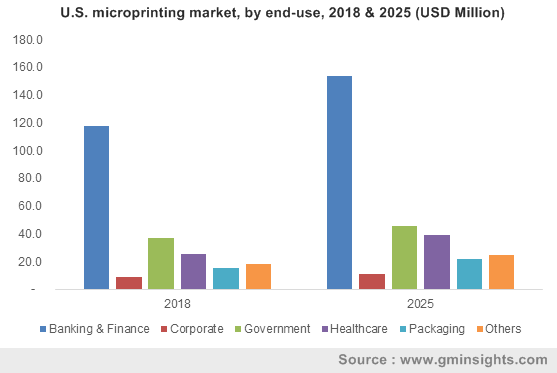A concise overview of the global microprinting market dynamics – how will the elevating awareness regarding forgery fuel the industry landscape?
Publisher : Fractovia | Published Date : 2019-05-22Request Sample
The global microprinting market is poised to garner hefty proceeds in the ensuing years, on account of burgeoning demand for microprinting across a slew of industries to mitigate counterfeit products. Microprinting is a common security procedure adopted by a vast range of industries including government, banking & finance, corporate, packaging, and healthcare. According to a research report, the global microprinting market is projected to witness substantial gains and amass over USD 800 million by 2025.
U.S. microprinting market, by end-use, 2018 & 2025 (USD Million)

Although the commercialization of fake or pirated goods may seem harmless from the surface, it is a substantial threat to the society, which can undermine innovation and impede economic growth. In fact, the losses caused every year due to counterfeiting and forgery are enormous. Having said that the businesses operating in this particular industry are involved in rigorous research to develop hi-tech microprinting solutions, owing to which the business space stands to gain much over the ensuing years.
The increasing use of microprinting for objects which require authentication such as postage stamps, banknotes, product validation, stock certificates, identity cards, and passports is predicted to propel the microprinting industry landscape over the coming years. Microprinting activities procured by organizations include holograms, special paper, intaglio printing, watermarks, security threads, anti-copying marks, and serial number. Currency notes also make use of microprinting to restrict fraudulent & illegal money movement. In fact, most currency notes have tiny words dappled across the bigger images, which makes it nearly impossible to replicate them.
How are illicit trade and counterfeiting impacting the microprinting industry?
The globalization of trade & communication has amplified the opportunities for organized crimes, as a result, scenarios of illicit trade and counterfeiting have become an everyday affair. In the same regard, Atlanta based city Decatur gathered headlines recently by citing an increase in the circulation of counterfeit currency throughout the city. Such crimes have not only emerged as a serious economic challenge but also pose a threat to social and environmental wellbeing.
For instance, one freight container of counterfeit cigarettes signifies more than $900,000 in state and federal tax losses for the United States. The reforms enacted by law enforcement agencies pertaining to illicit trade & intellectual property crimes are anticipated to accentuate the adoption of microprinting across the globe in the time to come.
How is the brand factor pushing microprinting market trends?
Brand image is the overall impression in the customers’ mind that is molded from all information sources. No business can ever survive with a crippled brand image, and merchandise forgery can put an organization’s credibility at risk. There is an array of industries, like packaging & healthcare, which are in constant need for cost-effective and superior quality security prints, that ease the identification of products and mitigate product duplicity, while simultaneously upholding brand identity and goodwill. According to credible reports, distribution of counterfeit and substandard goods represents as much as 2.5 percent of the world trade equaling to about USD 461 billion, claims a report by Organization for Economic Co-operation and Development.. In addition, the global data pertaining to customs seizures demonstrates that the brands with the most knockoffs include Rolex, Louis Vuitton, Nike, and Ray Ban. Hence, the need to avert the huge losses suffered by businesses due to forged goods and the rising need to protect brand image will accelerate the growth pace of microprinting industry.
A sneak peek into the recent developments in the microprinting market:
- German researchers have reportedly developed a revolutionary anti-counterfeit technology rooted in 3D microprinted structures, which can, in future, replace present-day 2D structures like holograms. Karlsruhe Institute of Technology’s spin-off company Nanoscribe has developed a device which can be used to create security entities through multistep 3D optical laser lithography technique. The benefit of using 3D-printed microstructures is that counterfeit protection can be exponentially increased, as these structures have a side length of about 100 µm making them barely visible with naked eyes. In addition to this, the individual character of this security feature as well its complexity makes forging certainly difficult. In the coming years, this technology could be implanted in the foil to act as safety tags for branded goods such as medicinal or automotive products, or integrated into the transparent space of bank notes.
- Prellis Biologics Inc., a human organ and tissue engineering company, and CELLINK, a biotechnology startup, have entered into a collaboration agreement to market high-resolution holographic bio-printing technology for microprinting. This is the first system supporting ultra-high resolution bio-printing of microstructures like capillaries or vascular networks. Moreover, this technique is a significant add-on to CELLINK’s bioprinting platform based on extrusion, as it will help attain anatomically relevant result by using combined prints from two distinct technologies.
- France has recently witnessed the merger of two different realms of technology – 3D and 2D. The high-resolution 3D microprinting technology company Microlight3D has purchased Smart Force Technologies, specializing in maskless lithography tools for 2D printing of microstructures. The acquisition will enable Microlight3D, which currently offers 3D printers for an array of scientific and industrial applications, to add 2D printing competencies to its microprinting portfolio, along with continuing progress in the domain of Microsensors, Metamaterials, Microfluidics, Microelectronics, Microoptics, and Cell biology.
In the present world, the emergence of a strong legal framework to confine contraband and illicit trade has lent greater global appeal to the product, thereby pushing microprinting market trends. Moreover, based on the constant research and development initiatives led by market behemoths, along with the growing adoption of the product in banking and financial services sector, the microprinting industry is certain to observe sizable development in the years ahead.